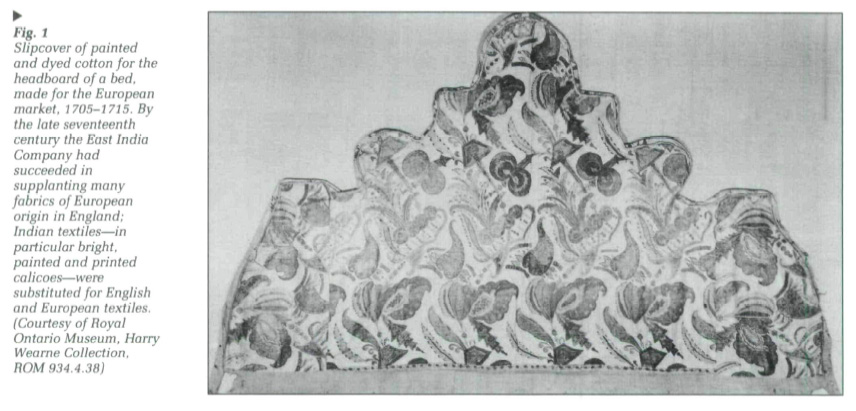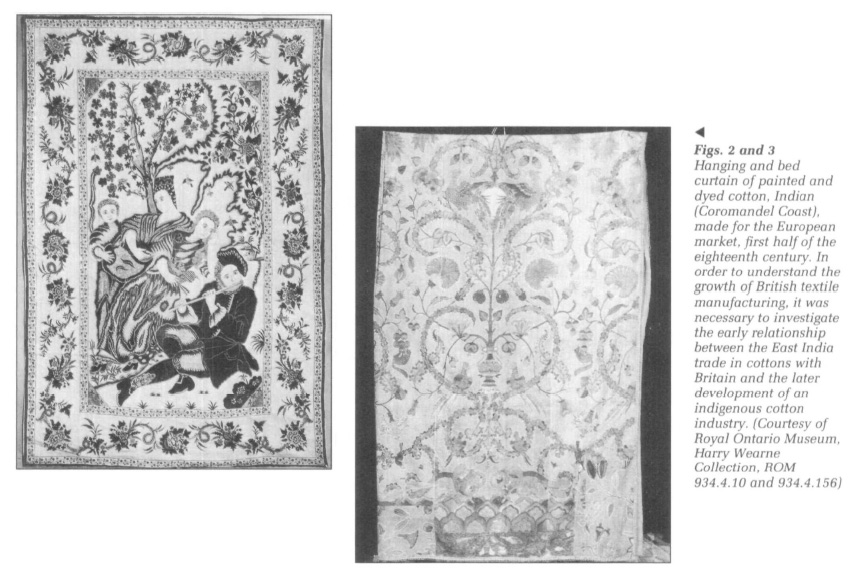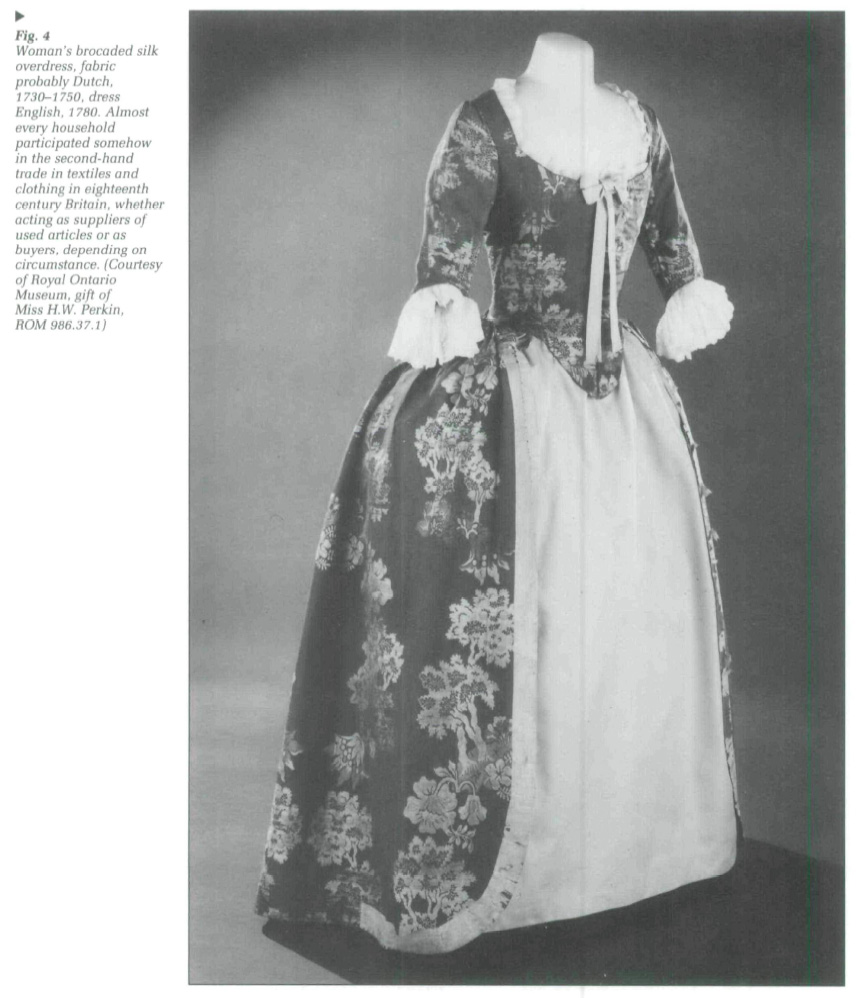Popular Consumption and the Mass Market / Consommation populaire et débouchés
Reflections on the Character of Consumerism, Popular Fashion and the English Market in the Eighteenth Century
Abstract
The investigation of demand as a significant economic factor has progressed to a more detailed appraisal of consumer practice. However, in this area of study there has been no attention paid to the second-hand trade and related consumption of clothing. Demand can best be seen as two-tiered. The first level of demand for new articles has up to this time obscured the wide trade in used apparel, the extensive market in second-hand goods. An examination of consumerism cannot be complete without taking into account the role played by the second-hand trade, the manner in which goods were used and dispersed throughout the nation. The implications of this trade to the rise of popular consumerism must be considered. Related questions that arise include the connection between the second-hand trade and industrialized textile production; the nature of popular fashion, its scope within society, and its impact on this trade; and whether this trade was a reflection of elements of national culture.
Résumé
Les recherches consacrées à l'importance de la demande en tant que facteur économique ont débouché sur un examen plus détaillé des pratiques de consommation. Ce champ d'étude n'a cependant fait aucune place jusqu'à maintenant au commerce et à la consommation de vêtements usagés. Il convient d'envisager deux paliers de demande. Le premier, la demande d'articles neufs, a occulté jusqu'ici le commerce considérable du «déjà-porté», l'important marché des marchandises d'occasion. Une étude de la consommation ne saurait être complète si l'on ne tenait pas compte du rôle qu 'a joué le commerce des produits usagés et de la façon dont les biens de consommation ont été utilisés et dispersés dans l'ensemble du pays. Il importe de voir comment ce commerce a influé sur la montée de la consommation de masse. À cet examen viennent se greffer un certain nombre de questions, entre autres sur le lien entre le commerce du «déjà-porté» et la production industrialisée des produits textiles, sur la nature de la mode populaire, l'ampleur du phénomène au sein de la société et son influence sur ce commerce de biens usagés, ainsi que sur la possibilité que ce commerce ait été le reflet d'éléments de la culture nationale.
1 Over the past decade historical enquiry into the nature of demand and the characteristics of the market in pre-industrial England has intensified, focusing on more detailed appraisals of consumer practice. The expansion of productive forces and the mechanization of production have commonly been seen as the touchstones of change. The desires and needs of the population—the intensity of popular demand and the way in which this demand was manifested—is as vital an area of enquiry, yet has suffered historic undervaluation. Popular consumerism is now the object of historians' sustained attention, beginning with Joan Thirsk Economic Policy and Projects: The Development of a Consumer Society in Early Modern England, an original study of the development of consumer manufactures in small-scale production during the sixteenth century. There followed Neil McKendrick's investigation of consumerism's general features in the eighteenth century in The Birth of a Consumer Society, and the related assessment of the role of small pedlars in the distribution and sale of goods during the seventeenth century by Margaret Spufford in The Great Reclothing of Rural England. More recently, Lorna Weatherill's Consumer Behavior and Material Culture in England, 1660-1760 provided valuable new additions to the field with a detailed appraisal of consumer practice in England, while Grant McCracken, in Culture and Consumption, developed an interdisciplinary approach in his work on historical anthropology. These represent some of the most pertinent works produced to date in this area of enquiry.
2 My entry into the study of consumer practice and demand began with a fascination with the English cotton industry. The growth and mechanization of this pivotal enterprise generated a great number of volumes on the subject of the technological, organizational, and structural changes in the cotton trade.1 However, the questions to which I wished to see responses did not relate simply to the technological or supply side of the process, but rather to the broader social and economic environment in which the cotton industry grew. Previously, too little consideration was given the role of the English market in spurring the growth of this industry. My studies convinced me that, to a great degree, the conditions in England during the decades of development provided a prime stimulus for the expanded manufacture and sale of cottons.
3 Some of the elements investigated included the attitudes of British consumers to the products of the cotton industry, the influence of popular fashion and the social levels at which demand was manifested. Not only did the British market require more investigation but so too did the early relationship between the East India trade in cottons with Britain and the later development of an indigenous cotton industry. The characteristics of the market, and the relationship between that society and the product, were central to an assessment which considered the full environment.
4 By the late seventeenth century the East India Company had succeeded in supplanting many fabrics of European origin in England; Indian textiles, in particular bright, painted and printed calicoes, were substituted for English and European textiles. The wealthy elite, the middling ranks, and even some of the labouring population demonstrated a willingness to alter their purchasing practices and to buy as well completely new sorts of commodities as substitutes for various traditional items. Commentators like Daniel Defoe noted people's changing preferences during the early-eighteenth century, when he wrote that "everything that used to be made of wool or silk, relating either to the dress of the women or the furniture of our houses, was supplied by the Indian trade."2 But alterations in demand extended beyond substitution, to the creation by the East India Company of new needs, as in the case of window curtains and cotton underwear. Ready-made furnishings and clothing found a steadily expanding market and a new "necessity" was gradually identified.3 A central factor in this process was the cultivation of popular fashion by company officials and independent entrepreneurs.
5 However, the popularizing of fashion and the encouraging of the consumer habit were antipathetic to strongly held attitudes about the nature of the social hierarchy—the danger of luxury among the common folk. The new craze for calicoes that swept much of society threatened long-standing views about the nature and function of trade, and it challenged powerful political forces in the shape of the landowners, wool merchants and weavers.4 Extensive popular consumption of articles designated "luxuries" not only threatened the established social norms but also jeopardized political and economic interests. Tension within that society spawned campaigns by these groups to force Parliament to try to curb new patterns of consumption.
6 The prohibition of cotton textiles in 1721 was a clear attempt by the English government to restrain social and economic forces seen as antagonistic to the political structures of the period. Ironically, it established instead a nurturing environment for the development of an indigenous manufacturing enterprise, the still fragile domestic cotton industry. In an economic environment sheltered from East Indian cottons, their most pressing competitor, the domestic manufacturers of cottons, slowly began to develop. What appears to me to be most important about the subsequent maturation of this industry was the continuing evolution of avenues through which fashion information could be disseminated and the imperfectly understood phenomenon of a broad allegiance to fashion which characterized the nation during this period. To attempt to comprehend the societal motivation, the functioning of the fashion stimulus, and the interaction of fashion related commodities within England, a more integrated assessment is required of the cultural, economic and social structures operating in England at that time.
7 During the course of research into demand and consumption in the eighteenth century, numerous accounts of attitudes towards clothing and dress have been uncovered in court records, newspaper accounts and diaries. The numbers of such references are suggestive, as too are the comments made. Englishmen and Englishwomen did not have distinct regional patterns of dress or a national costume. Costume historians describe instead several common styles of dress that extended geographically and socially throughout the country. Research into the material culture of dress among the English population seems to suggest that clothing patterns actually reveal a very cohesive aspect of national culture.5 Linda Colley recounted the manner in which such a national culture was exhibited through written accounts in newspapers, books and in associations.6 She found common outlooks and precepts that were reflected in political and economic attitudes. Might there not also be national cultural manifestations mirrored in dress? Perhaps all types of fashionable clothing, new or old, could be described as the "national costume" of England at this time, a costume of the most advanced capitalism, materialized through the popularization of fashion.
 Display large image of Figure 1
Display large image of Figure 18 Research into the eighteenth century market, consumerism and fashion, as they related to the cotton industry, led me to the first discovery of sources related to the second-hand clothing and textile trade. In fundamental ways, the nation-wide trade in used textiles, driven by popular demand, appeared to be a precursor to industrial production. Second-hand trade in textiles and clothing is one of the least-known facets of England's commercial and social life. Nevertheless, information exists which indicates that almost every household participated somehow in this trade, whether acting as suppliers of used articles or as buyers, depending on circumstance.
9 The economic structure of England was infinitely complex. About the more prominent sectors much is known. What cannot be overlooked is that, in addition, what might be called a peripheral informal sector operated at a variety of levels using barter as well as cash exchanges in trade. One such informal trade sector was in used clothing and textiles. Very little has yet been published on these informal alternative markets in used goods, and the implications of these operations have only just been considered.7 The second-hand trade appears to have been pervasive geographically and socially and to have juxtaposed ancient barter practices with cash-based trade. Describing the history of markets, Fernand Braudel wrote that, "there is not simple linear history of the development of markets. In this area, the traditional, the archaic and the modern or ultra-modern exist side by side."8 In eighteenth-century England, the modern has too frequently seized the attention of historians to the exclusion of the more humble and arcane practices. Consideration of the nature and function of fashion and consumerism must include more extensive study of the second-hand trade and the implications of the broad consumer participation associated with the selection and exchange of goods. Such a study could present difficulties. Nevertheless, it would pay historians to enter these less-travelled avenues. They will then know better how the interplay of formal and informal economic endeavours contributed to the overall transformations of this period.
10 Future assessments of these phenomena might hope to answer questions which, as I see it, can be grouped in two categories: first, what are the functional components of the second-place trade, and second, what is the significance of the trade as a cultural and social barometer of attitudes and relationships? On the first issue, of the functioning of this trade, research can attempt to determine the involvement of various segments of the population with the second-hand trade as well as how generally it flourished and in association with what other kinds of trade. This research could also focus on the gender composition of those at work in the trade and the distribution of tradespeople throughout the country. In what ways did the second-hand trade contribute to a cultural cohesion, as well as a common consumerism? How did the second-hand trade fit into cultural practices of this period? Did this humble trade manifest a particular preoccupation with appropriate dress? What does it tell us about the influence of fashion among various social ranks, and did the trade in used clothing expand the numbers able to participate in the marketplace?
 Display large image of Figure 2
Display large image of Figure 211 Initial research in the trade of used goods demonstrates what is, in effect, a two-tiered level of demand. Members of the lower orders were not barred from the market but were one step removed from the commercial participants most commonly noted.9 The numbers of traders who operated inside and outside the country suggests, as well, the universality of this humble enterprise.10 One must then reconsider current estimates of the numbers of those able to participate in the expanding consumer society and the way in which this sort of trade affected conditions prior to the industrialization of the cotton industry. The second-place trade in clothing is an important indicator of a level of demand heretofore overlooked. The demand for textiles and clothing of all sorts, whether it be knitted stockings, painted calicoes or checked curtains, is a particularly sensitive indicator of social and economic developments within the nation. It reflects common aspirations and is surely a gauge of the material culture of the era. Researchers assessing the history of consumerism, its development and characteristics, should attempt to assess this phenomenon from as broad a perspective as possible in order that all facets of experience are taken into account.
 Display large image of Figure 3
Display large image of Figure 3